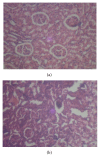Phenolic Acids (Gallic and Tannic Acids) Modulate Antioxidant Status and Cisplatin Induced Nephrotoxicity in Rats
- PMID: 27382634
- PMCID: PMC4897306
- DOI: 10.1155/2014/984709
Phenolic Acids (Gallic and Tannic Acids) Modulate Antioxidant Status and Cisplatin Induced Nephrotoxicity in Rats
Abstract
Cisplatin (cis-diamminedichloroplatinum (II) or CDDP), used in the treatment of many solid-tissue cancers, has its chief side-effect in nephrotoxicity. Hence, this study sought to investigate and compare the protective effect of gallic acid (GA) and tannic acid (TA) against cisplatin induced nephrotoxicity in rats. The rats were given a prophylactic treatment of GA and TA orally at a dose of 20 and 40 mg/kg body weight for 7 consecutive days before the administration of a single intraperitoneal (i.p.) injection of cisplatin (CP) at 7.5 mg/kg bwt. The protective effects of both GA and TA on CP induced nephrotoxicity were investigated by assaying renal function, oxidative stress biomarkers, and histopathological examination of kidney architecture. A single dose of cisplatin (7.5 mg/kg bwt) injected i.p. caused a significant increase in some biomarkers of renal function (creatinine, uric acid, and urea levels), with a marked elevation in malondialdehyde (MDA) content accompanied by a significant (P < 0.05) decrease in reduced glutathione (GSH) content (103.27%) of kidney tissue as compared to control group. Furthermore, a significant (P < 0.05) reduction in kidney antioxidant enzymes (SOD, catalase, GPx, and GST) activity was observed. However, pretreatment with oral administration of tannic acid and gallic acid at a dose of 20 and 40 mg/kg body weight, respectively, for 7 days prior to cisplatin administration reduced histological renal damage and suppressed the generation of ROS, lipid peroxidation, and oxidative stress in kidney tissues. These results indicate that both gallic and tannic acids could serve as a preventive strategy against cisplatin induced nephrotoxicity.
Figures





Similar articles
-
Tannic acid mitigates cisplatin-induced nephrotoxicity in mice.Hum Exp Toxicol. 2012 Feb;31(2):145-56. doi: 10.1177/0960327111414282. Epub 2011 Jul 1. Hum Exp Toxicol. 2012. PMID: 21724663
-
Ameliorative Effects of Gallic Acid on Cisplatin-Induced Nephrotoxicity in Rat Variations of Biochemistry, Histopathology, and Gene Expression.Biomed Res Int. 2021 Oct 26;2021:2195238. doi: 10.1155/2021/2195238. eCollection 2021. Biomed Res Int. 2021. PMID: 34746299 Free PMC article.
-
Effects of mycophenolate mofetil on cisplatin-induced renal dysfunction in rats.Cancer Chemother Pharmacol. 2007 Mar;59(4):455-60. doi: 10.1007/s00280-006-0284-8. Epub 2006 Jul 20. Cancer Chemother Pharmacol. 2007. PMID: 16855841
-
Glycyrrhizic acid: a phytochemical with a protective role against cisplatin-induced genotoxicity and nephrotoxicity.Life Sci. 2011 Sep 26;89(13-14):422-9. doi: 10.1016/j.lfs.2011.06.016. Epub 2011 Jul 7. Life Sci. 2011. PMID: 21803049
-
Carnosic acid attenuates renal injury in an experimental model of rat cisplatin-induced nephrotoxicity.Food Chem Toxicol. 2011 Dec;49(12):3090-7. doi: 10.1016/j.fct.2011.08.018. Epub 2011 Sep 6. Food Chem Toxicol. 2011. PMID: 21930180
Cited by
-
Pharmacological effects of gallic acid in health and diseases: A mechanistic review.Iran J Basic Med Sci. 2019 Mar;22(3):225-237. doi: 10.22038/ijbms.2019.32806.7897. Iran J Basic Med Sci. 2019. PMID: 31156781 Free PMC article. Review.
-
Phytochemical profiling and antioxidant potential of Daphne mucronata Royle and action against paracetamol-induced hepatotoxicity and nephrotoxicity in rabbits.Saudi J Biol Sci. 2021 Sep;28(9):5290-5301. doi: 10.1016/j.sjbs.2021.05.051. Epub 2021 May 26. Saudi J Biol Sci. 2021. PMID: 34466107 Free PMC article.
-
Ameliorative effect of tannic acid on hypermethioninemia-induced oxidative and nitrosative damage in rats: biochemical-based evidences in liver, kidney, brain, and serum.Amino Acids. 2020 Dec;52(11-12):1545-1558. doi: 10.1007/s00726-020-02913-5. Epub 2020 Nov 13. Amino Acids. 2020. PMID: 33184691
-
The diminution and modulation role of water-soluble gallic acid-carboxymethyl chitosan conjugates against the induced nephrotoxicity with cisplatin.Sci Rep. 2022 Nov 19;12(1):19903. doi: 10.1038/s41598-022-21681-8. Sci Rep. 2022. PMID: 36402822 Free PMC article.
-
Water Extract from Brown Strain of Flammulina velutipes Alleviates Cisplatin-Induced Acute Kidney Injury by Attenuating Oxidative Stress, Inflammation, and Autophagy via PI3K/AKT Pathway Regulation.Int J Mol Sci. 2023 May 29;24(11):9448. doi: 10.3390/ijms24119448. Int J Mol Sci. 2023. PMID: 37298398 Free PMC article.
References
-
- El-Sayed E. M., Abd-Ellah M. F., Attia S. M. Protective effect of captopril against cisplatin-induced nephrotoxicity in rats. Pakistan Journal of Pharmaceutical Sciences. 2008;21(3):255–261. - PubMed
-
- Goldstein R. S., Mayor G. H. The nephrotoxicity of cisplatin: minireview. Life Sciences. 1983;32(7):685–690. - PubMed
-
- Masuda H., Fukumoto M., Hirayoshi K., Nagata K. Coexpression of the collagen-binding stress protein HSP47 gene and the alpha 1(I) and alpha 1(III) collagen genes in carbon tetrachloride-induced rat liver fibrosis. The Journal of Clinical Investigation. 1994;94(6):2481–2488. doi: 10.1172/JCI117617. - DOI - PMC - PubMed
LinkOut - more resources
Full Text Sources
Other Literature Sources
Research Materials
Miscellaneous

